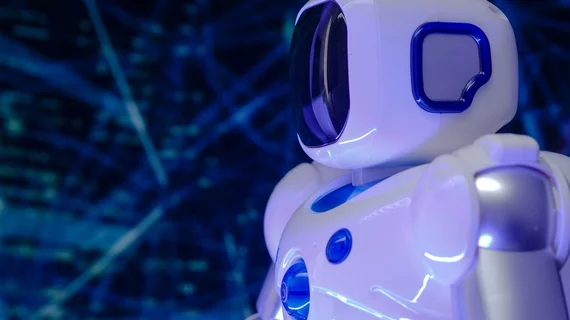10 robots for cranial neurosurgery on the market or in the works
Robotics are changing brain surgery. How so? Let a team of experts count the ways.
Publishing a paper on the topic June 30 in Operative Neurosurgery, neurosurgeons Tyler Ball, MD, of the University of Louisville, Chengyuan Wu, MD, of Thomas Jefferson University and colleagues note that their overview is based not on a comprehensive survey but on their professional observations from the field.
The authors concentrate on robotic technologies that either augment a surgeon’s movements or simplify a multistep process.
Left out are machines that “execute a simple translational or rotational movement under direct surgeon control.”
Ten applications meet their discussion criteria. They are, as follows:
CorPath GRX Robotic System | Translational and rotational endovascular catheter movements. Role: Telesurgery. Can execute catheter manipulation on behalf of the primary surgeon. Commercially available (Corindus).
DaVinci surgical system | Floor-mounted robot translates surgeon’s hand movements from a remote console. Role: Telesurgery. Can execute microsurgical movements on behalf of the primary surgeon, with scalable movements, tremor filter, wristed instruments and 3-dimensional visualization. Widespread use in urologic, gynecologic, and general surgery, but currently limited to cadaveric studies for cranial surgery.
Follow-the-leader curved needles | Guide therapeutic device to target via a “predetermined” but nonlinear path driven via a MRI-compatible robotic actuator. Role: Nonlinear frameless stereotaxis along complex paths. Robotic actuation can execute movements on behalf of the primary surgeon. Potentially telesurgery. Research stage.
Magnetic navigation systems | Guide therapeutic device to target via dynamic changes in a magnetic field. Role: Stereotactic guidance with degrees of freedom not possible with tactile methods. Potentially radiosurgery. Research stage.
Mazor Renaissance | Skull-mounted robotic arm to align and maintain linear trajectory. Role: Frameless stereotaxis with semiautomated targeting. No longer commercially available.
NeuroArm | Open surgical maneuvers (scalable in amplitude and speed). Role: Telesurgery. Can execute microsurgical movements on behalf of the primary surgeon, potentially with fine motor augmentation (scalable movements, tremor filter). Prototype built and successfully used clinically, but not commercially available.
Neuromate | Floor-mounted robotic arm to align and maintain linear trajectory. Role: Frameless stereotaxis with semiautomated targeting. For endoscopy, can function as a surgical assistant (retraction, lighting, correlation of location with navigation). Commercially available (Renishaw).
ROSA | Floor-mounted robotic arm to align and maintain linear trajectory. Role: Frameless stereotaxis with semiautomated targeting. For endoscopy, can function as a surgical assistant (retraction, lighting, correlation of location with navigation). Commercially available (Zimmer Biomet).
Stealth Autoguide | Mayfield clamp-mounted robotic arm to align and maintain linear trajectory. Role: Frameless stereotaxis with semiautomated targeting. Commercially available (Medtronic).
SurgiScope | Ceiling-mounted surgical microscope capable of frameless robotic stereotaxis. Role: Can be used for frameless stereotaxis with semiautomated targeting. Commercially available (ISIS Robotics).
None of the authors has a vested interest in any of the devices described in the article, Ball et al. note.
The team concludes:
Technological capabilities of robots will continue to advance with increased computational power and enable safer, more efficient surgery. While there are currently well-defined roles for robotics in frameless stereotaxis, SEEG [stereoelectroencephalography] and endoscopy, the role of robotics in other portions of intracranial surgery is less defined. However, available technology shows promise in being able to augment other areas of neurosurgery.”
The paper is available in full for free.

